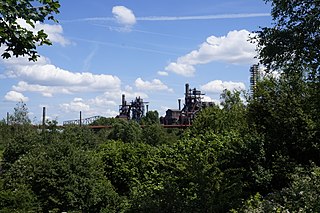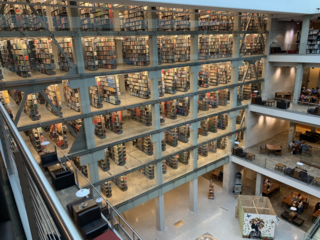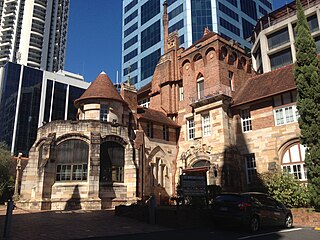
An amphitheatre or amphitheater is an open-air venue used for entertainment, performances, and sports. The term derives from the ancient Greek ἀμφιθέατρον, from ἀμφί, meaning "on both sides" or "around" and θέατρον, meaning "place for viewing".
The Melbourne Museum is a natural and cultural history museum located in the Carlton Gardens in Melbourne, Australia.
Landforms are categorized by characteristic physical attributes such as their creating process, shape, elevation, slope, orientation, rock exposure, and soil type.
The University of Technology Sydney (UTS) is a public research university located in Sydney, New South Wales, Australia. The university was founded in its current form in 1988, though its origins as a technical institution can be traced back to the 1870s. UTS is a founding member of the Australian Technology Network (ATN), and is a member of Universities Australia (UA) and the Worldwide Universities Network (WUN).

Southbank is an inner-city suburb in Melbourne, Victoria, Australia, 1 km south of the Melbourne central business district, located within the Cities of Melbourne and Port Phillip local government areas. Southbank recorded a population of 22,631 at the 2021 census.

In geology, a hummock is a small knoll or mound above ground. They are typically less than 15 meters (50 ft) in height and tend to appear in groups or fields. Large landslide avalanches that typically occur in volcanic areas are responsible for formation of hummocks. From the initiation of the landslide to the final formation, hummocks can be characterized by their evolution, spatial distribution, and internal structure. As the movement of landslide begins, the extension faulting results in formation of hummocks with smaller ones at the front of the landslide and larger ones in the back. The size of the hummocks is dependent on their position in the initial mass. As this mass spreads, the hummocks further modify to break up or merge to form larger structures. It is difficult to make generalizations about hummocks because of the diversity in their morphology and sedimentology. An extremely irregular surface may be called hummocky.

Glacial landforms are landforms created by the action of glaciers. Most of today's glacial landforms were created by the movement of large ice sheets during the Quaternary glaciations. Some areas, like Fennoscandia and the southern Andes, have extensive occurrences of glacial landforms; other areas, such as the Sahara, display rare and very old fossil glacial landforms.

Brisbane Central Technical College is a heritage-listed technical college at 2 George Street, Brisbane City, City of Brisbane, Queensland, Australia. It was built from 1911 to 1956. It became the Queensland Institute of Technology (QIT) in 1965, and then in 1987 that became the Queensland University of Technology. It was added to the Queensland Heritage Register on 27 August 1999.

Bascom Hill is the iconic main quadrangle that forms the historic core of the University of Wisconsin–Madison campus. It is located on the opposite end of State Street from the Wisconsin State Capitol, and is named after John Bascom, former president of the University of Wisconsin.

Brisbane Square is a high-rise building in Brisbane, Queensland, Australia. The building has 38 floors and rises to 151 metres. The building's main use is for office space, the lower floors leased to retailers, with a 350-space car park below the building. Significant tenants include the Brisbane City Council and Australian Retirement Trust.

Landschaftspark is a public park located in Duisburg-Meiderich, Germany. It was designed in 1991 by Latz + Partner, with the intention that it work to heal and understand the industrial past, rather than trying to reject it. The park closely associates itself with the past use of the site: a coal and steel production plant and the agricultural land it had been prior to the mid 19th century.

The William Oxley Thompson Memorial Library is the main library at Ohio State University's Columbus campus. It is the university's largest library and houses its main stacks, special collections, rare books and manuscripts, and many departmental subject libraries. The library was originally built in 1912, and was renovated in 1951, 1977, and 2009. It is named in honor of the university's fifth president, William Oxley Thompson.
The "Orpheion", also known as the Orpheion Theater, is a traditional outdoor Greek hillside theater on the Irving, Texas, campus of the University of Dallas.

St Martin's House is a heritage-listed former private hospital and now administration building within the grounds of St John's Cathedral at 373 Ann Street, Brisbane City, City of Brisbane, Queensland, Australia. It was designed by Lange Leopold Powell and built c. 1922 by Thomas Keenan. It is also known as St Martin's Hospital. It was added to the Queensland Heritage Register on 21 October 1992.

Celal Gökhan Avcıoğlu is a Turkish architect. He is the principal and founder of GAD in Istanbul, established in 1994. At GAD, Avcıoğlu has completed a number of projects of varying function and size in Turkey and regionally.

222 Exhibition Street is a 26 level office building in Melbourne, Australia. Constructed 1986-88 and designed by Denton Corker Marshall, 222 Exhibition Street is a notable example of Postmodernism by a firm that was later to gain international fame.

The New Law School building of the University of Sydney is designed by Sydney-based architectural firm Francis-Jones Morehen Thorp (FJMT). The building is located at the university's Camperdown campus in Sydney, New South Wales, Australia and was officially opened on 30 April 2009. It serves as the new building for the Sydney Law School.

Pilot Knob State Park is located southeast of Forest City, Iowa, United States. Founded in 1923, it is one of the oldest state parks in Iowa. Between 1990 and 1995 one area was named nationally recognized historic district and five structures were individually listed on the National Register of Historic Places.

The Sir Duncan Rice Library is the main academic library for the University of Aberdeen. It was designed by Schmidt Hammer Lassen Architects and completed in 2011. It is named after Duncan Rice, a previous Principal of the university. The cube-shaped building can be seen prominently from the entire campus and much of the city. It is a seven-storey tower, clad in zebra-like jagged stripes of white and clear glass. The building has a floorspace of 15,500 square metres. It houses several of the University's historic collections, including more than a quarter of a million ancient and priceless books and manuscripts that have been collected over five centuries since the University's foundation. There is also public exhibition space. The library replaced the smaller Queen Mother Library as the university's main library.

Western Bank Library is a library at the University of Sheffield located on Western Bank, forming part of the Western Bank Campus. Formerly the Main Library, it is a Grade II* listed building opened in 1959 by Nobel prize-winning poet T. S. Eliot. The library was designed and built as a result of a national competition announced by the university in 1953. It was the university's main library until the Information Commons was opened in April 2007. Western Bank Library is linked to the Arts Tower via a bridge between their mezzanine floors. The two buildings are intended to be viewed together according to their architect Gollins Melvin Ward.





















